The Voyage of Life - Manhood is a series of painting completed by Thomas Cole in 1842. The painting represents an allegory of four stages of life that every human being goes through. Other paintings forming this allegory represented childhood, youth, and old age.
Thomas was passionate about advancing the landscape painting in a manner that depicted universal truths about life and existence of human beings in relation to religious faith and nature. In 1836, Cole conceived the idea of painting an allegory of portraits that reflected his ambition. Many sources claim that Cole was inspired by existing traditional allegories from older painters like John Bunyan's allegory of Pilgrim's Process.
Cole's process to paint his Voyage of Life series started in 1839 in his old studio located at Cedar Grove-Catskill, New York. Cole commenced his work following a laborious process that characterized the art-making profession in the nineteenth century. Cole sourced some of his materials from Edward Dechaux in New York City. Cole used oil and canvas as the primary medium and used a common technique of mixing oil and solid colours to create an image of stable landscape features. The art industry was facing technological transformations at the time where some art materials began to be delivered while already stretched, including pre-prepared canvases. However, Cole was not contented with the already-processed canvases and premixed colours, claiming that the quality was being compromised.
Thomas Cole was a religious person who intended to use his talent to depict nature and stages of life. In his paintings Cole uses a river flowing through every canvas to represent the twists and turns of everyman's life. Every painting depicts different time and season to represent different stages of life. Just like in many poems written by Cole, the Manhood painting shows the idea of the passing of time and the concept of irreversible aging. The idea of mortality is seen to have disturbed Cole and dictated his personality from a comparatively early age.
Cole finished his series of allegory of life in the mid-1850s and started travelling across the world, showcasing them. All the four paintings were widely available in America for public exhibition. The moral message accompanying these paintings was appealing to the public, and many Americans hung the reproductions of these paintings in their parlours. Due to this wide publicity, Cole's lessons and teachings on life and religion were passed on to future generations.
Cole's work attracted many rich religious citizens in America. One such person was a wealthy and deeply entrenched religious banker, Samuel Ward. Ward offered Cole $5,000 to acquire the complete allegory of Voyage of Life. Ward had a personal art gallery where he wanted to display the paintings with an aim to educate visitors and his children on morality. Unfortunately, Ward died before the allegory paintings were completed. Heartbroken and yet determined, Cole continued with his series to completion. The painting of Manhood has been owned by the National Gallery of Art, Washington D.C since 1971.




